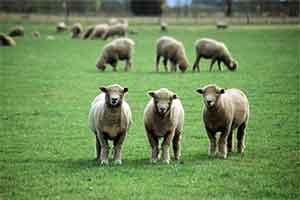Agricultural fertiliser could pose risk to human fertility, sheep study finds
 Eating meat from animals grazed on land treated with commonly-used agricultural fertilisers might have serious implications for pregnant women and the future reproductive health of their unborn children, according to new research.
Eating meat from animals grazed on land treated with commonly-used agricultural fertilisers might have serious implications for pregnant women and the future reproductive health of their unborn children, according to new research.
The study by British and French scientists from the universities of Nottingham, Aberdeen (UK) and Paris-Saclay (France), The James Hutton Institute (Aberdeen) and UMR BDR, INRA, Jouy en Josas (Paris, France) published in the journal Scientific Reports, has shown striking effects of exposure of pregnant ewes – and their female lambs in the womb – to a cocktail of chemical contaminants present in pastures fertilised with human sewage sludge-derived fertiliser.
Dr Richard Lea, of the School of Veterinary Medicine and Science at The University of Nottingham, was lead author on the paper.
He said: “The study highlights potential risks associated with the common practice of grazing livestock on pastures on which human sewage sludge-derived fertiliser has been used.
“More worryingly, since low-level chemical exposure poses a threat to human reproductive development, the consumption of products from animals grazing such pastures may be of considerable environmental concern.”
The research group investigated development of ovaries in the foetal sheep, which is very similar to ovary development in humans, exposing the pregnant sheep to sewage sludge-derived fertiliser to simulate ‘real-life’ exposure. Since the number of eggs present in the ovary at birth is determined while still in the womb, the research shows that the implications of disrupted ovary development could be significant. It suggests that chemicals that interfere with this development process, particularly those that mimic sex steroids, may have long-lasting effects on adult female fertility.
The researchers report that the number of eggs in the foetus’ ovary was reduced even if the period of exposure was limited to 80 days corresponding to early, mid or late gestation. However, a period of mid or late gestation exposure had a greater effect on the development of the foetus and the number of altered genes and proteins in the foetus’ ovary.
Professor Paul Fowler of the University of Aberdeen, who coordinated the €2.9m study funded by the European Commission, said: “The biggest effects on the foetal ovary were seen when the sheep were switched to sewage sludge fertilised fields in the last two to three months of pregnancy. While this suggests that changing exposures to chemical mixtures may be worse than always being exposed to these mixtures, steps to reduce contamination of sewage sludge-derived fertiliser are welcome.”
Source: University of Nottingham
Full bibliographic information:
“The fetal ovary exhibits temporal sensitivity to a ‘real-life’ mixture of environmental chemicals”


